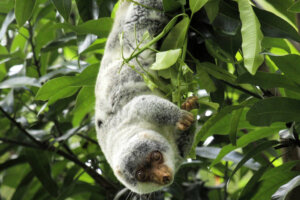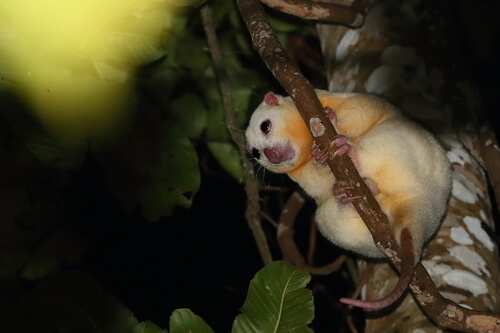Common Spotted Cuscus: Characteristics, Habitat and Reproduction


Written and verified by the psychologist Sara González Juárez
Many animals inhabit the treetops, but not many of our natural history books. This is the case with the common spotted cuscus, an arboreal marsupial that, like the skunk, is capable of releasing a foul odor to ward off predators.
When you think of arboreal marsupials, examples rarely appear except for the koala. Here’s one more proof that nature hides surprises for all those who choose to go beyond the limitations of popular knowledge.
Taxonomy and characteristics of the Common Spotted Cuscus
The Common Spotted Cuscus (Spilocuscus maculatus) belongs to the family Phalangeridae and to the order Diprotodontia. Although it’s often confused with a primate, it’s actually more closely related to the opossum.
It’s a marsupial mammal that weighs 3-6 kilograms (6.6 to 13.2 pounds) and is about half a meter (1.6 feet) long. Males are larger than females, but this isn’t the only sign of sexual dimorphism: while the males are white with reddish or brown spots, female specimens are entirely white.
They also have a prehensile tail that allows them to cling to tree branches and move with greater agility. They also have short, strong limbs, with 5-fingered hands and strong claws for combing and clinging to tree trunks.
Habitat
This animal is endemic to Australia and New Guinea, where it inhabits forests and jungles in both wet and dry climates. Both shouldn’t be found at high altitudes, as the common spotted cuscus only moves in ranges of 500-1000 meters (1650 to 3300 feet) above sea level.
It has also been sighted in freshwater and saltwater mangrove forests.
It’s common to find that this geographic range is also shared with the Southern common cuscus (Phalanger mimicus) and the common brushtail possum (Trichosurus vulpecula). Many of the confusions come from this cohabitation.
Although it’s an omnivorous species, the diet of Spilocuscus maculatus is essentially folivorous. It usually consumes fern leaves, climbing plants, ficus, or piper betle. It tends to be selective and prefers young shoots and leaves.
More occasionally and infrequently it can be found consuming unripe fruits, especially coconut. It also consumes fruits of plants of the Pometia family and small vertebrates or insects very infrequently.
Behavior
The common spotted cuscus is nocturnal and exclusively arboreal. During the day it sleeps in the forest vegetation, where it hides with foliage so that predators can’t find them.
It has also been documented that they never spend time together, except to breed. Each individual is solitary and has its own foraging and resting area. When they meet, they often try to drive each other aggressively, especially if they’re males.
They communicate through a repertoire of calls and vocalizations. There isn’t much research on this, but whistles, squeaks, and clicks have been documented. Females make a specific call during the breeding season to find a mate.
Common spotted cuscus reproduction
This species doesn’t have a specific breeding period, and they breed throughout the year. Males breed with several females (polygyny) and this is the only time when they share space with other specimens.
The litter size isn’t usually high, as the availability of food in the area influences the reproductive capacity of the spotted cuscus. They usually breed only once a year and have no more than one offspring.
Females have an estrous cycle of 28 days.
The gestation period of the female lasts from 20 to 42 days. At the time of parturition, the baby will remain inside the marsupium, suckling until it’s big enough to come out. This occurs at 5-7 months of age. Thereafter, the mother will carry her baby on her back until it’s independent.
Conservation status

Spilocuscus maculatus is currently in a state of least concern (LC) according to the IUCN. The population is stable and isn’t fragmented. However, it is indexed in CITES Appendix II.
Although its population doesn’t appear to be endangered, experts are concerned about it due to a mixture of factors. The first is the low reproductive rate of only one mating per year when resources permit. The second is hunting by the local population for the consumption of their meat and the sale of their parts.
Fortunately, several specimens live in protected areas, where experts and study them and expand their knowledge about the species. Even so, actions for their conservation shouldn’t be abandoned, as these animals are susceptible to becoming endangered at any time.
Many animals inhabit the treetops, but not many of our natural history books. This is the case with the common spotted cuscus, an arboreal marsupial that, like the skunk, is capable of releasing a foul odor to ward off predators.
When you think of arboreal marsupials, examples rarely appear except for the koala. Here’s one more proof that nature hides surprises for all those who choose to go beyond the limitations of popular knowledge.
Taxonomy and characteristics of the Common Spotted Cuscus
The Common Spotted Cuscus (Spilocuscus maculatus) belongs to the family Phalangeridae and to the order Diprotodontia. Although it’s often confused with a primate, it’s actually more closely related to the opossum.
It’s a marsupial mammal that weighs 3-6 kilograms (6.6 to 13.2 pounds) and is about half a meter (1.6 feet) long. Males are larger than females, but this isn’t the only sign of sexual dimorphism: while the males are white with reddish or brown spots, female specimens are entirely white.
They also have a prehensile tail that allows them to cling to tree branches and move with greater agility. They also have short, strong limbs, with 5-fingered hands and strong claws for combing and clinging to tree trunks.
Habitat
This animal is endemic to Australia and New Guinea, where it inhabits forests and jungles in both wet and dry climates. Both shouldn’t be found at high altitudes, as the common spotted cuscus only moves in ranges of 500-1000 meters (1650 to 3300 feet) above sea level.
It has also been sighted in freshwater and saltwater mangrove forests.
It’s common to find that this geographic range is also shared with the Southern common cuscus (Phalanger mimicus) and the common brushtail possum (Trichosurus vulpecula). Many of the confusions come from this cohabitation.
Although it’s an omnivorous species, the diet of Spilocuscus maculatus is essentially folivorous. It usually consumes fern leaves, climbing plants, ficus, or piper betle. It tends to be selective and prefers young shoots and leaves.
More occasionally and infrequently it can be found consuming unripe fruits, especially coconut. It also consumes fruits of plants of the Pometia family and small vertebrates or insects very infrequently.
Behavior
The common spotted cuscus is nocturnal and exclusively arboreal. During the day it sleeps in the forest vegetation, where it hides with foliage so that predators can’t find them.
It has also been documented that they never spend time together, except to breed. Each individual is solitary and has its own foraging and resting area. When they meet, they often try to drive each other aggressively, especially if they’re males.
They communicate through a repertoire of calls and vocalizations. There isn’t much research on this, but whistles, squeaks, and clicks have been documented. Females make a specific call during the breeding season to find a mate.
Common spotted cuscus reproduction
This species doesn’t have a specific breeding period, and they breed throughout the year. Males breed with several females (polygyny) and this is the only time when they share space with other specimens.
The litter size isn’t usually high, as the availability of food in the area influences the reproductive capacity of the spotted cuscus. They usually breed only once a year and have no more than one offspring.
Females have an estrous cycle of 28 days.
The gestation period of the female lasts from 20 to 42 days. At the time of parturition, the baby will remain inside the marsupium, suckling until it’s big enough to come out. This occurs at 5-7 months of age. Thereafter, the mother will carry her baby on her back until it’s independent.
Conservation status

Spilocuscus maculatus is currently in a state of least concern (LC) according to the IUCN. The population is stable and isn’t fragmented. However, it is indexed in CITES Appendix II.
Although its population doesn’t appear to be endangered, experts are concerned about it due to a mixture of factors. The first is the low reproductive rate of only one mating per year when resources permit. The second is hunting by the local population for the consumption of their meat and the sale of their parts.
Fortunately, several specimens live in protected areas, where experts and study them and expand their knowledge about the species. Even so, actions for their conservation shouldn’t be abandoned, as these animals are susceptible to becoming endangered at any time.
All cited sources were thoroughly reviewed by our team to ensure their quality, reliability, currency, and validity. The bibliography of this article was considered reliable and of academic or scientific accuracy.
- Leary, T., Singadan, R., Menzies, J., Helgen, K., Wright, D., Allison, A., Aplin, K. & Dickman, C. 2016. Spilocuscus maculatus. The IUCN Red List of Threatened Species 2016: e.T20636A21950307. https://dx.doi.org/10.2305/IUCN.UK.2016-2.RLTS.T20636A21950307.en. Accessed on 13 October 2022.
-
Spilocuscus maculatus (short-tailed spotted cuscus). (s. f.). Animal Diversity Web. Recuperado 13 de octubre de 2022, de https://animaldiversity.org/accounts/Spilocuscus_maculatus/
This text is provided for informational purposes only and does not replace consultation with a professional. If in doubt, consult your specialist.








